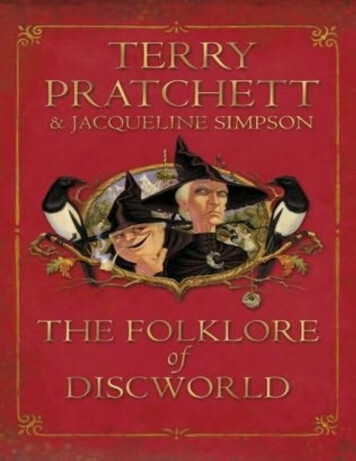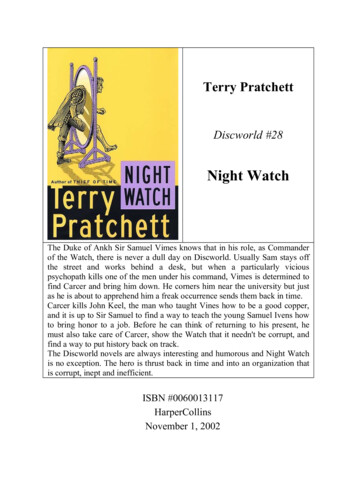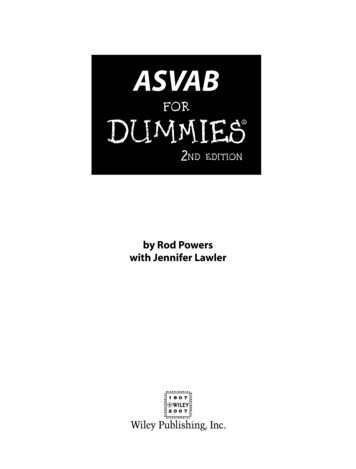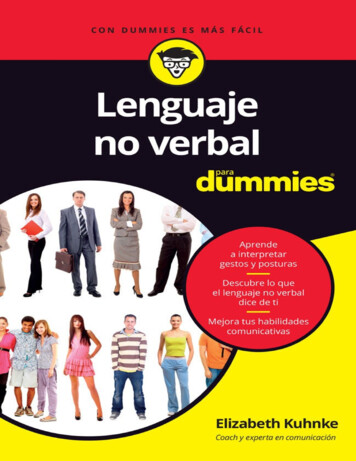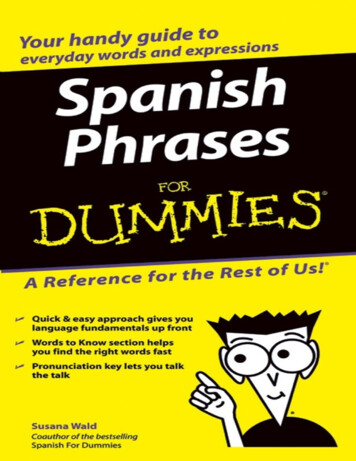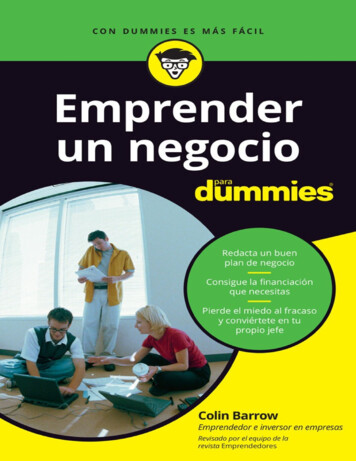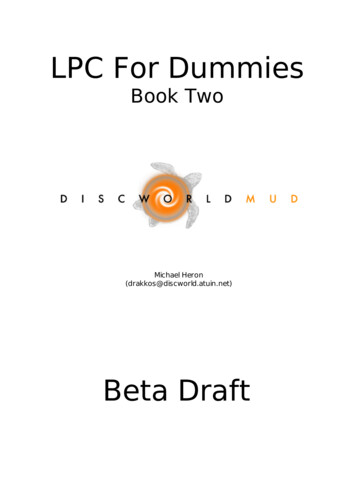
Transcription
LPC For DummiesBook TwoMichael Heron(drakkos@discworld.atuin.net)Beta Draft
LPC For Dummies 2, First EditionTable of ContentsMojo The Monkey Says.5The Mudlib Strikes Back.6Introduction.6Betterville.6The Village Plan.7A Word Of heritance.9Hooking It All Up.10Replace Program.11Success!.12However.14Multiple Inheritance And Scope Resolution.15Our Betterville Room Inherit.16Visibility.18The Impact Of Change.19Conclusion.20The Library Quest.21Introduction.21Data Representation.21In A Class Of Your Own.25The Library State.27Dynamic Quest Design.28The Rest Of The Quest.29Conclusion.30Adding Commands.31Introduction.31Deciding On A User Interface.31Adding Commands.33More On Patterns.36Optional Parameters and Set Choices.38Direct and Indirect Objects.39Passed Parameters .39Tannah's Pattern Matcher.40Conclusion.41The Library Room.42Introduction.42The Room.42Guess The Syntax Quests.47Viewing The Blurb.47The Sort Command.48Except, not quite.51Conclusion.53Quest Handlers.55Michael HeronPage 2
LPC For Dummies 2, First EditionIntroduction.55The Handlers.55Cast Your Mind Back.56Quest Utils.57Our Second Quest.58Conclusion.61Our Last Quest.62Introduction.62The Quest Design.62Handlers.63The Portrait Handler.64Back To The Library.69Conclusion.71Finishing Touches.72Introduction.72The Second Level Room.72I'm Looking Through. uh. behind you.73Ecretsay Odecay.74Random Guessing.76What Kind Of Day Has It Been?.77Conclusion.78Gold Diggers.79Introduction.79The Dozy-Girl Template.79Event Driven Programming.82The Power of Inherits.85Conclusion.86Lady Tempesre.87Introduction.87The Lady.87Shopkeeper Disincentives.89The Disembowel Handler.90Data Persistence.92Effective User Identifiers.93Conclusion.97Beastly Behaviour.98Introduction.98Combat Actions.102Smart Fighters.103Bitwise Operators.105Relating Back to Smart Fighter.108Bitwise and Arrays.109Conclusion.109Shopping Around.110Introduction.110Item Shop Inherit.110An Item Shop.111Item Development.112Auto Loading.113Michael HeronPage 3
LPC For Dummies 2, First EditionDressing Up.115Back To The Auto Loading.116Doing It Better.117Back To Our Shop.118Conclusion.120Spelling It Out.121Introduction.121The Anatomy of a Spell.121More Complex Spells.127Spellbinding.129Conclusion.131Cause and Effect.132Introduction.132What's An Effect?.132The Power of Effects.135Working With Effects.138Bits and Pieces.140Conclusion.141Function Pointers.142Introduction.142The Structure of a Function Pointer.142The Four Holy Efuns.144Back To The Library.147Function Pointer Support.148A Few More Things About Function Pointers.150Conclusion.151Achieving Your Potential.152Introduction.152Achievements and Quests.152How Often Should I Add Achievements?.153My First Achievement.154Criteria.156Criteria Matching.157A Little More Complicated.160Other Achievement Settings.162I've written an achievement! What now?.163Ack, it sucks! How do I get rid of it?.163Achievement Levels.164Conclusion.165So Here We Are Again.166Introduction.166What's On Your Mind?.166Help Us To Help You.167Where Do You Go From Here?.167Conclusion.168Reader Exercises.169Introduction.169Exercises.169Send Suggestions.171Michael HeronPage 4
LPC For Dummies 2, First EditionMichael HeronPage 5
LPC For Dummies 2, First EditionMojo The Monkey Says.All rights, including copyright, in thecontent of these documents are ownedor controlled by the indicated author.You are permitted to use this materialfor your own personal, non-commercialuse. This material may be used,adapted, modified, and distributed bythe administration of Discworld MUD(http://discworld.atuin.net – try theveal) as necessary.You are not otherwise permitted tocopy, distribute, download, transmit,show in public, adapt or change in anyway the content of these web pages forany purpose whatsoever without the prior written permission of the indicated author(s).If you wish to use this material for non-personal use, please contact the authors of the texts forpermission.If you find these texts useful and want to give less niche programming languages a try, come checkout http://www.monkeys-at-keyboards.com for more free instructional material.My apologies for the unfriendly legal boilerplate, but I have had people attempt to steal ownershipof my material before.Please direct any comments about this material to drakkos@discworld.atuin.net.That's mojo at the top right. He's very clever. He has a B.A in Nanas!Michael HeronPage 6
LPC For Dummies 2, First EditionThe Mudlib Strikes BackIntroductionWelcome to LPC for Dummies Two - the intermediate level material forDiscworld Creators. Before progressing to this material, you should be surethat you understand the material presented in LPC For Dummies 1, and theBeing A Better Creator material. For this text, the assumption will be that youhave read both of these, and understand them all entirely. This is especiallyimportant for the coding side of things - seriously, if you don't understand eversingle thing in LPC For Dummies 1, you shouldn't think about attempting thisbook. I assume a lot of you at this point.Once we progress beyond the basics of LPC coding, it becomes possible to dosome very fun things - however, the theory and practise gets considerablymore complex when we start talking about commands and quests, so it'simportant for you to be willing to persevere. Before we progress to the Meatand Taters of this set of learning material, let's recap on what we're going tobe doing as our worked example.BettervilleWe've set ourselves quite the challenge for our second learning village. We'veset the theme of an area with a secret path that leads to a deserted, ruinedtower. Within our tower, we have decided upon three quests: Sort the library Break through the secret area to the second level Find and unlock the secret passagewayIn particular, we have set ourselves the task of making these quests, as far asis possible, dynamic. That, more than anything else, provides a substantialchallenge to our development skills.We have also decided on a range of NPCs to populate our area. First we havethe Dozy Girls - wannabe princesses looking to cash in on a misunderstoodlocal story. We have our shopkeeper, who is the lost lover of the beast andthus protected by his wrath.For our last NPC, we have the Beast - our star attraction. This is not a bossNPC but is instead a flavour monster that fleshes out the back-story. Highinteractivity is important here.Michael HeronPage 7
LPC For Dummies 2, First EditionFinally, we have also decided on some features for the area. We have ourlibrary, which is the biggest draw to the village, and our local shop which isfull of accessories for gold-digging teenage girls.Along the way, we're going to look at building the coding infrastructure of thisdevelopment. It has quite a complex make-up of features, and we want to beable to make sure it all works correctly and can be changed easily andefficiently. However, what we won't be doing is focusing on the descriptionsvery much - this is a coding manual, not a writing manual, and as withLearnville our focus is on making the development actually work, not withmaking sure it reads well. It also won't be 'feature complete' - we don't learn alot by doing a dozen variations on the same theme, and so we will talk abouthow to do something once and leave it as exercise for the reader to fill in theblanks.The Village PlanWe decided upon a layout quite early in Being A Better Creator - to recap:6/ \5 7\ /4/3 2/ \18\9Our first step is going to be to setup this framework. We're going to do it alittle bit differently to how we did Learnville. This is LPC for Dummies Twoafter all - we do things Bigger and Better!The biggest change we're going to make is in the architecture - we're notgoing to use the standard inherits for our rooms, we're going to create ourown set of inherits. This gives us tremendous flexibility over sharedfunctionality for rooms and NPCs. That will be our first goal with the village putting the rooms together. You may think 'ha, I've already done that withLearnville', but not like this you haven't - trust me.Michael HeronPage 8
LPC For Dummies 2, First EditionA Word Of CautionThe quests we write as part of this material are not supposed to be tutorialsfor how to write your own quests. We will cover certain key Discworldconcepts in the process of building these, but you shouldn't think that anyquest you write will be written the same way. The important thing in all of thismaterial are the tools and techniques you use, rather than the product youend up building. This is an important point - you shouldn't think of any of thisas a blueprint, it's just a process that is used to put together a complex area.What you should be paying most attention to is the theoretical asides, such aswhen we talk about handlers, or inherits - essentially any of the 'science bits'.It is understanding when and where these programming constructs anddesign patterns should (and should not) be used that is by far the mostimportant element of LPC for Dummies 2.So please, don't just copy and paste the code that is provided - the code is thething that is safest to ignore! Why the code was written in the way it waswritten though - ah, there be knowledge!ConclusionFasten up tight kiddies, there's some pretty treacherous terrain ahead. By theend of this book, if you've understood everything on offer, you'll have thenecessary toolkit to be able to code objects that will fascinate and delightyoung and old. You won't know all there is to know about LPC, but you'll knowmore than enough to be a Damn Fine Creator. Many creators over the yearshave been content to write descriptions and develop simple areas, and there isnothing wrong with that. However, when you want to do something that isgenuinely cool, you need to know how the code for it is put together. That'swhat we're here for!Michael HeronPage 9
LPC For Dummies 2, First EditionInheritanceIntroductionWhen we built the infrastructure for Learnville, we made use of the standardinherits provided by the game for inside and outside rooms, as well as forNPCs. This is a solid strategy, but one that limits your options for adding inarea-level functionality. In this chapter, we are going to build a series ofcustom inherits for our new and improved area. These will be specializationsof the existing inherits (we’re not going to have to have much code in them),but they’ll make our lives easier as we go along.Inheritance is one of the most powerful features of object orientation, and oneof the reasons why the Discworld Mudlib is so flexible to work with as acreator. However, the cost of this is in conceptual complexity - it's notnecessarily an easy thing to get your head around.InheritanceThe principle behind inheritance is simple – it’s derived from the biologicalprinciple of children inheriting the traits of their parents. In coding terms, itmeans that a child (an object which inherits) gains access to the functions andvariables defined in the parent (the object from which it is inheriting). That'swhy functions like add item work in the rooms we code. Some other creatorwrote the add item method, stored it in the code that defines a room, and aslong as we inherit the properties of being a room in our own object, we toohave access to that function. If you inherit /std/object, you will find theadd item function is no longer available.At their basic level, inherits look something like this:inherit "/std/outside";void create() {do setup ;::create();do setup--;// My Code In Here}if (!do setup) {this object()- setup();this object()- reset();}Michael HeronPage 10
LPC For Dummies 2, First EditionThere is no requirement for an inherit to inherit anything itself, but since thisis going to be our outside room inherit, we’ll take advantage of having anobject that already does all the work for us.The create() method is common to all LPC objects – it’s what the driver callson the object when it loads it into memory. The code here is slightly abstract,so don’t worry too much about what it means. In brief, what it’s doing ismaking sure that setup() and reset() get called at the right time when anobject is created. Without this, you get weird things like double add items andsuch. Don’t worry about it, it just has to be there.Any code that we would normally put in the setup of an object can go betweenthe two blocks of code, where the comment says ‘my code in here’. Forexample, if you want every room in your development to have an add item,you can do that:inherit "/std/outside";void create() {do setup ;::create();do setup--;add item ("bet
important for the coding side of things - seriously, if you don't understand ever single thing in LPC For Dummies 1, you shouldn't think about attempting this book. I assume a lot of you at this point. Once we progress beyond the basics of LPC coding, it becomes possible to do some very fun things - however, the theory and practise gets .
